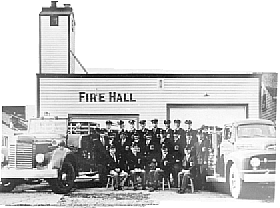A Model-A-Ford truck was purchased in June 1941 for $250 and after a great deal of work by Mr. Rimbey the first motorized fire truck for the village was put into service. It carried a 200-gallon water tank and as they had no pump the tank was pressurized by Carbon dioxide which forced the water out through the hose. During the construction of the Alaska Highway the village fire department received assistance from the American Army’s fire department which had a 1939 Chevrolet 250 Gallon/Minute fire truck. The village managed to procure this truck in 1943 and at this time Mr. Floyd Wilson was appointed Fire Chief, a position which he held for 13 years.
During this time Floyd gave a great deal of his time and energy improving fire-fighting facilities. In November 1951, the village purchased a Lafrance 600 GPM truck and in December 1955 purchased a used 500 GPM pumper. The 1939 Chevrolet was retired and turned over to the water-works department.
 In June 1956 I was hired full-time and appointed Assistant Fire Chief and in January 1957 was appointed Chief when Mr. Wilson stepped down due to the pressure of his business. In 1958 we hired one man and in November 1961 when we moved from the old station which was located where Keeler Painting supplies is now, into our present quarters, an additional 5 men were hired. In 1967 the city purchased an 840 GPM King-Seagrave pumper. Today we have a force of 12 paid men and 30 volunteers. Our fleet consists of the following: a 1942 pumper, a 1951 pumper, a 1967 pumper, a rescue and safety van, a pick-up truck and a station wagon — all are radio equipped.
In June 1956 I was hired full-time and appointed Assistant Fire Chief and in January 1957 was appointed Chief when Mr. Wilson stepped down due to the pressure of his business. In 1958 we hired one man and in November 1961 when we moved from the old station which was located where Keeler Painting supplies is now, into our present quarters, an additional 5 men were hired. In 1967 the city purchased an 840 GPM King-Seagrave pumper. Today we have a force of 12 paid men and 30 volunteers. Our fleet consists of the following: a 1942 pumper, a 1951 pumper, a 1967 pumper, a rescue and safety van, a pick-up truck and a station wagon — all are radio equipped.
In January 1970 the department took over the ambulance service using the station wagon until we were presented with an Econoline van, purchased by the local Kinsmen Club and equipped by the city. The total cost was approximately $7, 500. Since taking over the ambulance service, we have answered a total of 570 calls, which averages out to approximately 20 per month, although in March of 1972 we answered a total of 35 calls. The area we cover is to the Alberta border, to the Peace River at Clayhurst, the Kiskatinaw River on the Alaska Highway and to the East Pine on the Hart Highway. Cost to patients in city limits is $15 per call. Calls beyond the city limits for residents is $15 plus $.50 per running mile and non-residents are charged $30 plus $1 per running mile. Transfers between Pouce Coupe and St. Joseph General Hospital are Resident $20 and non-resident $25. All men have first-aid training and at present 7 have their industrial tickets.
Our average call outs to fires or smoke checks over the past 5 years has been 180 calls per year. Fire loss averages approximately $90,000 per year except when you get a year like 1966 and 1968 when we lost the Senior High and Notre Dame schools. As a number of businesses in the city are fully sprinklered, a fire alarm sprinkler and heat indicator system was installed in the fire hall by a private firm. This is an exceedingly important feature of fire protection, as a large part of fire loss is charged to delay in discovery of fires. Our local hospital’s alarm system is also connected directly to the fire hall and at present our local school board are installing heat and smoke detectors in some of the schools and this system will also be connected directly in the hall.
We are constantly endeavoring to improve fire-fighting techniques, to obtain the best of equipment and to carry out a good inspection program. Schools, hotels and other places of public assembly are inspected every two months and an attempt is made to inspect business places on a regular basis. Our city today has an excellent insurance rating and no doubt it will continue to improve as long as we all work together to decrease our losses in fires.
Insurance rates are generally set by the following formula:
water supply–34%, fire department 30%, fire alarm 11%, police protection 1%,
building bylaws 4%, fire prevention 6%, structural conditions of buildings 14%.
The Municipality depends on its fire service, however we depend on the municipality for their continued support and co-operation in maintaining a fire safe city. I feel that when a city pays out money for maintaining or improving municipal fire protection, the city is investing money in an enterprise with anticipation of receiving regular benefits to the people of the community. Some of these dividends may be summarized as follows:
Greater safety against personal injury and accidental fire death for the people in the city.
Better job security for persons who are employed. It has been noted that many business or industrial enterprises either fail to re-open after a serious fire or are otherwise affected to the extent that some jobs are sacrificed and some business goes elsewhere.
Greater attractiveness to business and industry looking for an appropriate city in which to locate. One of the factors in which many look is the adequacy of public fire protection.
And as mentioned before, continued lower insurance rates.

